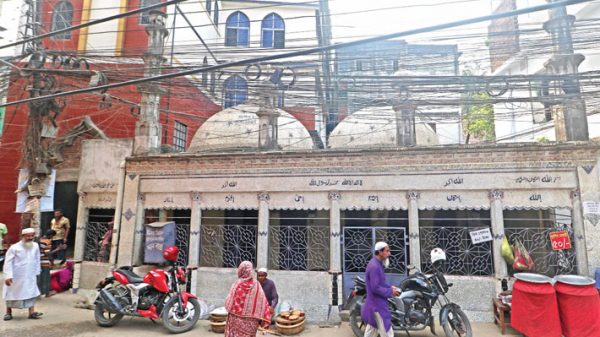Dhaka’s oldest surviving Binat Bibi Mosque in a sorry state

- Update Time : Sunday, September 4, 2022
- 115 Time View

The Binat Bibi Mosque’s structure offers nothing spectacular if the architectural aspect is considered but its specialty lies in its history. The five hundred and sixty six-year-old building is the oldest surviving mosque of Dhaka, a metropolis that is known as ‘the city of mosque’.
The mosque located in the north side of the Hayat Bepari Bridge on Narinda Road No. 6 in Old Dhaka dates back to as early as the pre-Mughal Sultanate period. It was built in 1457 (861 Hijri).
The history of building Binat Bibi Mosque has been engraved on a black stone on the body of the mosque in Persian language.
According to the inscription, some 150 years before the arrival of Islam Khan during the reign of Sultan Nasiruddin Mahmud Shah I, a Persian merchant named Arkan Ali started living in Narinda for business purposes. He built the mosque with a capacity of 30-40 devotees.
His beloved daughter Binat Bibi died suddenly and was buried near the mosque. Since then the edifice has been known as Binat Bibir Mosque. Saddened by the sudden death of his daughter, Arkan Ali also died after six months. He was buried next to his daughter adjacent to the mosque.Former Professor of Islamic History and Culture at Dhaka University Parween Hasan writes in her ‘Sultans and Mosques: The Early Muslim Architecture of Bangladesh’ that single hemispherical dome atop a square room, arches on south, north and eastern sides, octagonal turret, modest ornamentation, plaster coating and curved cornices are the original features of the Binat Bibi Mosque.
The four-cornered mosque, built on a site of about seven kathas, had a central dome in its original structure, but another dome was added during its renovation in 1930 (1337Hijri).
Binat Bibi mosque has seen four extensions to date. During the first extension around 90 years ago, a dome was built atop a room.
Around 20 years ago, a two-storey building was built beside the mosque. During third extension, it was turned into a four-storey building.
Finally, the four-storey building was extended to seven-storey structure and a high minaret with the ground floor abutting the original mosque.
The mosque has been operated by a committee formed by locals for the last 200 years. They built the new building with the donation of the locals to accommodate more devotees during the prayer time.
Unfortunately, the committee did not consult with any expert and show minimum respect towards the country’s heritage while constructing the new building.
Conservation architects requested them not to build a new minaret to avoid dissimilar design with Mughal structure. The architects also asked them to avoid vibration and pressure on the soil for saving the original structure from developing cracks, but they did not pay heed.
Besides, the original building of the age-old mosque has been losing its grandeur amid negligence while the grave of Binat Bibi and her father lie uncared-for.
Asked about the plan of Department of Archaeology regarding the conservation of the mosque, the government body’s Regional Director Rakhi Roy said they earlier sent a proposal to Dhaka’s deputy commissioner to determine the way of preserving the historic mosque but didn’t get any response.
“We will contact the deputy commissioner’s office again and take further steps considering the present situation of the ancient mosque,” she said.
The mosque is now used as Maktab in two shifts, morning and afternoon, to teach students Arabic language and the basics of Islam, including prayer, free of charge.
Binat Bibi mosque is one of the last remnants of Dhaka’s beautiful past. It must be preserved in proper way.















